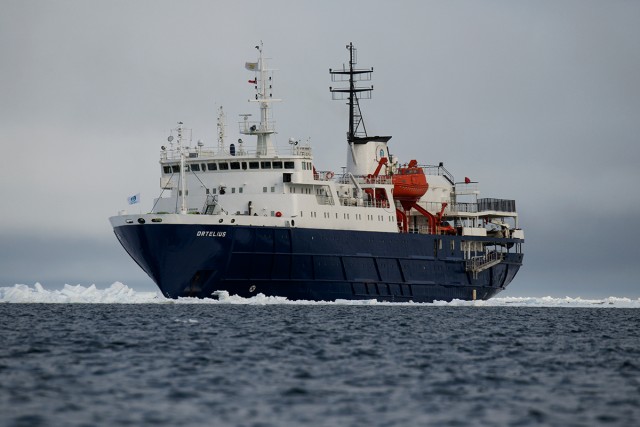
This is the M/V Ortelius, registered in Limassol Cyprus. It’s got the highest ice-class a vessel can attain. – Photo: Bernie Leighton | AirlineReporter
If you were to ask me to spend a week on a boat for all but maybe two reasons, I’d be likely to risk prison to get out of it. I don’t like boats, and I think that large cruise ships combine the worst of Las Vegas, a crowded beach, and a heaping helping of disease transmission. So, a sedate Caribbean or Mediterranean cruise is also out of the question. What are my two reasons, then? The first one is obvious; planes/missilery. The second one, less so; polar bears.
Before any of you go off on me for saying that this has nothing to do with riding on a Soviet relic, think again. In 1989, the then Soviet Academy of Sciences commissioned an ice-class expedition vessel for ambiguous purposes. This vessel, the Marina Tsvetaeva, was laid down and completed in Gydnia, Poland the same year!
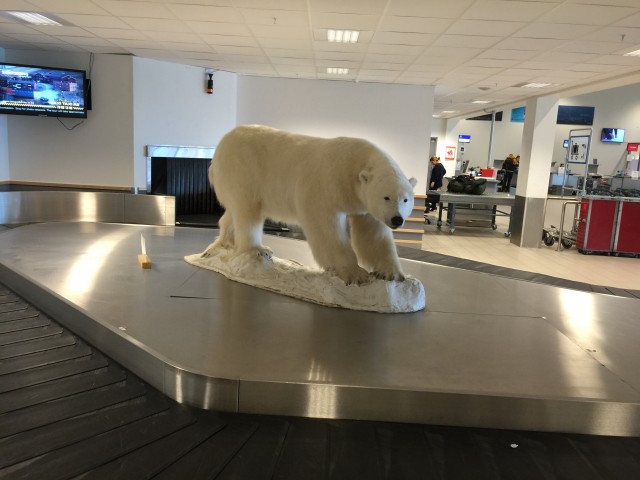
Welcome to bear country. Lufthavn Longyearbyen is located on a peninsula called Hotellnesset. – Photo: Bernie Leighton | AirlineReporter
After the collapse of the Soviet Union, the vessel was used for oil-field resupply in the Russian Far East, until expedition companies realized it would be the perfect boat for Antarctic charters. In 2011, Dutch company Oceanwide Expeditions acquired the ship and sent it in for a complete overhaul. From this, it would leave the Russian register, and its original name behind. Re-registered in Cyprus (a great Flag of Convenience), and named after Flemish cartographer Abraham Ortelius, it has been used for Antarctic and Arctic cruises since then.
This boat is also a piece of rock & roll history. In 2013, it carried Metallica, some prize-winning fans, and their equipment to the South Pole for the “Freeze ‘Em All” tour. This was in celebration of the thirtieth anniversary of the release of Metallica’s first album, “Kill ‘Em All!” At least, so the plaque in the ship’s “Krill ’em All” Bar says.
Having seen the creatures out on the tundra near Churchill, Manitoba, I was determined to see them when they were not bored out of their mind waiting for the ice to come in — I wanted to see them on the hunt. Two things are needed for that to be possible: sea ice and daylight. There are only a few reasonably accessible places in the world where you can get both at once. Hence, I made my way to Longyearbyen on the island of Spitsbergen, in Norway. I made the trip in SAS Plus, but It was such an unremarkable flight in all areas I didn’t even take an iPhone shot.
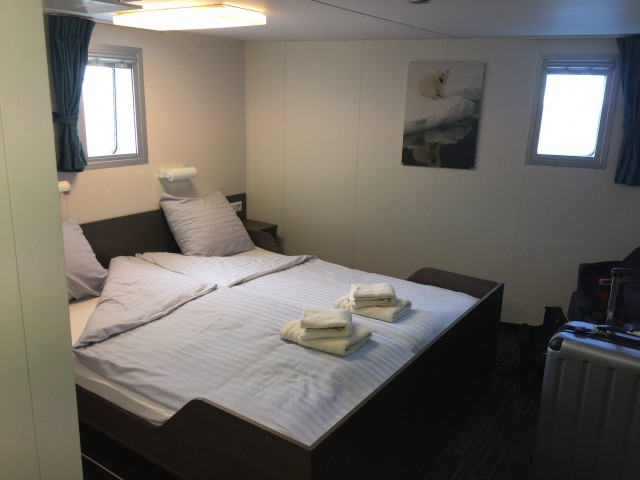
The best part of my Superior Cabin was not the large bed, but the amazing forward and starboard views provided – Photo: Bernie Leighton | AirlineReporter
NOTE: Just want to give you a heads-up that a bit down in the story, there is a photo of a bear that has recently fed. It is not too gruesome, but there is blood.
Two hours later, we made our way onto the Ortelius, where I was given a key to our room (I was traveling with my wife). I had booked a superior cabin as A. there were two of us and B. I don’t like boats, so I wanted as much space as possible so it felt “unboaty.” It was a lot less nautical than I was expecting; the toilet and shower all felt like things you would find in a hotel. The art was better than your average hotel, though. In retrospect, this makes sense, as this wasn’t your run-of-the-mill accommodations, but more of a luxury hotel – the “Hotel Department” aboard the Ortelius has 19 employees for around 100 guests.
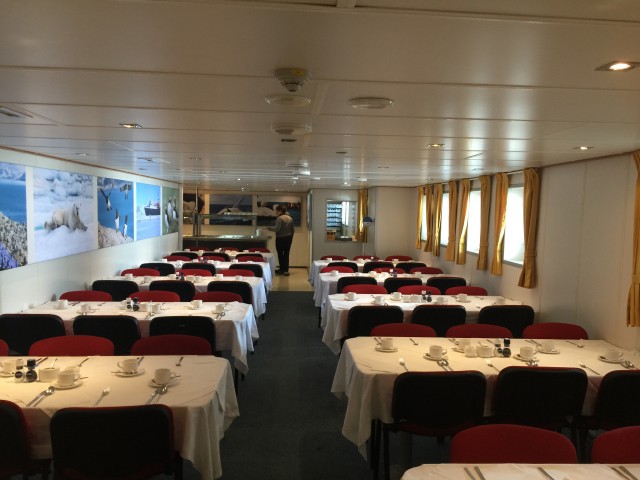
The dining room wraps around the rear of Deck 4; it can seat every passenger at once. Oddly, the actual galley is on Deck 3. – Photo: Bernie Leighton | AirlineReporter
Planes have safety demos and videos. Expedition cruise vessels have safety drills. What’s the difference? One requires passenger participation. So, prior to leaving Longyearbyen Harbor we made our way to our cabins to get our emergency life jackets. From there, it was up to be accounted for at the “muster point” (usually known as the bar/lounge). There was a storm coming in, which is better practice, because you quickly have the understanding of why you need to wear all your winter clothes for an evacuation. If the abandon ship call is given, you have to make your way into a lifeboat. Before that, though, out in the freezing wind. Even then, lifeboats aren’t exactly warm.
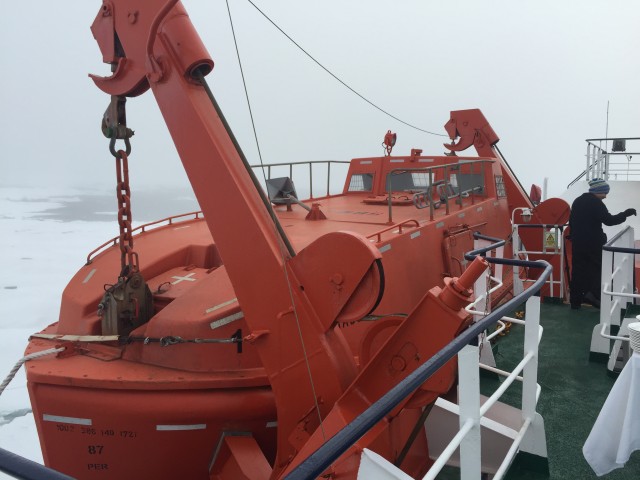
This is not built for comfort. But for you and 80 friends, you might just see another day if you make it in. – Photo : Bernie Leighton | AirlineReporter
It was too dark inside to get a photo with the minimal equipment I had in my pocket, but if you’ve ever seen the horror movie “Captain Phillips,” it looks exactly the same!
With that out of the way, it was time for our pre-departure beverage and dinner.
I never had a chance to take any photos of the meals on the entire voyage, so I may as well discuss them briefly. Breakfast and lunch were always a buffet. Breakfast consisted of one egg choice, one protein, and then one starch. Lunch would usually follow the motif of dinner. For example, if there was a generic Asian dish planned for the evening meal, lunch would be of that motif. The food, for an expedition cruise, was pretty good. Better than almost anything I had eaten since my Air Serbia flight. There were some rare misses in the middle of the week-long voyage at breakfast that were clearly a result of inventory concerns, but it was made up for the fact that the ship’s baker would always make an animal-themed bread!
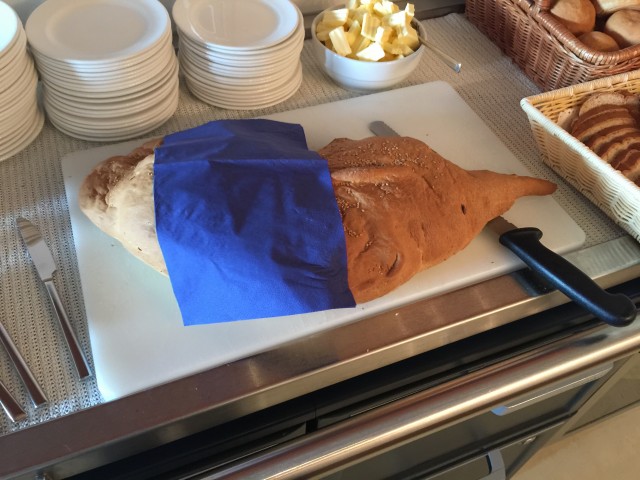
The baker would always make a sea creature-shaped loaf. Is this a goblin shark or a narwhal? – Photo: Bernie Leighton | AirlineReporter
Where was I?
Ah right, time to head to the ice. During boarding of the Ortelius, it was quite obvious there was a squall on the way. A rarity for the arctic at this time of year. Quite an extreme one, too. Shortly after dinner, things got crazy. Seas were 12-15 units (I asked someone to define, but he said neither feet nor meters). I don’t know which, could’ve been both! You could hear the boat slam down back on the water like a sledge hammer hitting the cabin. To be honest, I’ve been in way worse turbulence; I even took a shower.
The real problem was the noise of the curtains creaking as they swung away from, and then hit, the wall. They are important. That far north, it’s 24-hour daylight. How does it stay dark in a cabin? Ever seen an airplane window shade? Imagine that, but black and lockable under the curtains. Those creaked too.
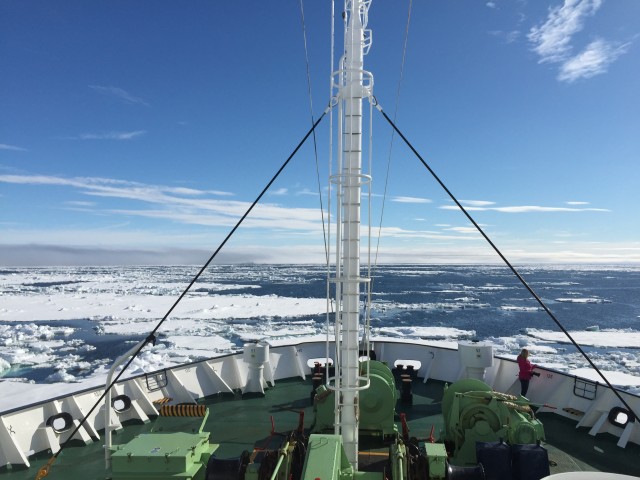
There are complex ecological reasons for this fact, however: if you want to go see polar bears, you need sea ice – Photo: Bernie Leighton | AirlineReporter
Other than a thick fog, the seas were Dà¸d Kalm. Too foggy to go on land, safely. Which meant no bears. Due to the weather, the captain and the expedition leader took us out of the fjà¸rd and back towards the ice. The next day, it was beautiful (pic above) and this is exactly what you want if you are looking for bears on the hunt. Well, you need one more ingredient: seals!
I think on the first day, our expedition leader lost track of how many tiny lumps in the distance he saw. There was, however, nothing that looked like a yellow smudge on the ice. Now, our expedition leader can spot a bear from 6.4 nautical miles away. I am not sure how, maybe he’s a super hero. It’s a very high-contrast environment, polar bears are masters of camouflage, and the ice is not perfectly flat. No joy the first day. Even with our expedition leader going into some sort of trance looking at the ice for 14 hours. It happens; going to the sea ice does not guarantee bears.
These things have a home range that makes Rhode Island seem even smaller than it is. Sometime late afternoon the next day, an announcement came over the ship’s PA that there was a bear, and anyone who wanted to see it should come outside. This packed the bow.
Before one goes on the bow, however, one must remember it’s freezing. So, add another ten minutes to get into cold weather gear before joining the scrum. It’s worth it, though.
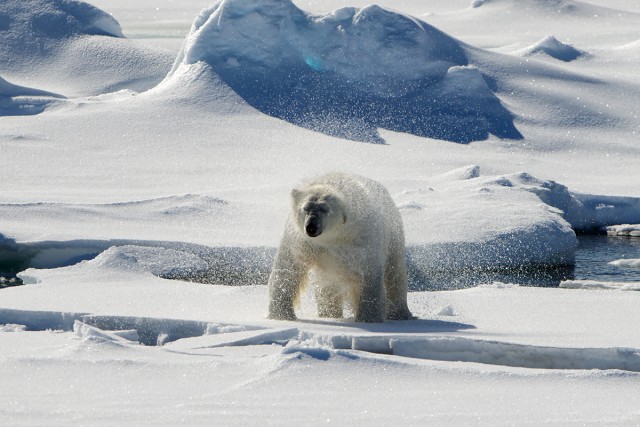
You are only legally allowed to drive so close to a polar bear. They can come closer to you, but they have to want to. This guy didn’t. Photo: Bernie Leighton | AirlineReporter
As the caption says, you cannot, legally, drive your 291-foot-long ship up to the bear and gawk at it. There are laws, and you can’t cause it distress. Let the bear make up its mind as to whether or not it wants to get closer.
The first, a very plump male, was not too keen on our presence. So, after about half-an-hour of trying to get away from him, we finally managed to part ways.
To give you some perspective, that picture above is a crop from 700mm of focal power (aka he was really far). Having spent so much time in Churchill, I was rather jaded by this bear. Sure, it was a UN level four or five (fattest or second-fattest), but it was so far away; also it wasn’t doing anything that unique. Half the reason I came up north was for a chance to see an ursus maritimus feeding. Oh well, maybe next day?
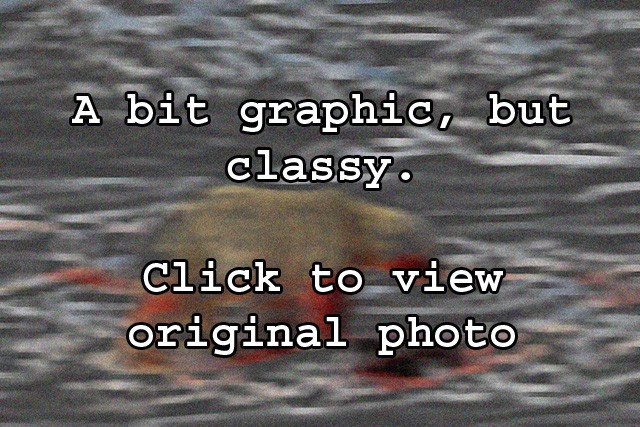
Bears with a fresh kill don’t care about what noise you make or how big your boat is. They mostly care about other bears – Photo: Bernie Leighton | AirlineReporter
It pays to have a very good polar bear guide leading your trip, as sometime next afternoon, it happened! We came upon a bear that had, very likely, just finished off the bearded seal it was feeding on a scant few minutes before. That, right there, made the trip worth it. But I am greedy, I wanted more!
Svalbard is also home to a large population of the world’s creepiest seal killer, the Atlantic Walrus. Again, I was lucky! The next day – well, close to midnight two days later – we were briefed that there was a sizable walrus colony on a beach a few miles away. Unfortunately, it was both too shallow a draught for the Ortelius to get close to, and also the noise could have scared them. How does one do this? Well, like some of our next expeditions, via a zodiac. It is there that I learned you should always keep your cameras protected from sea spray.
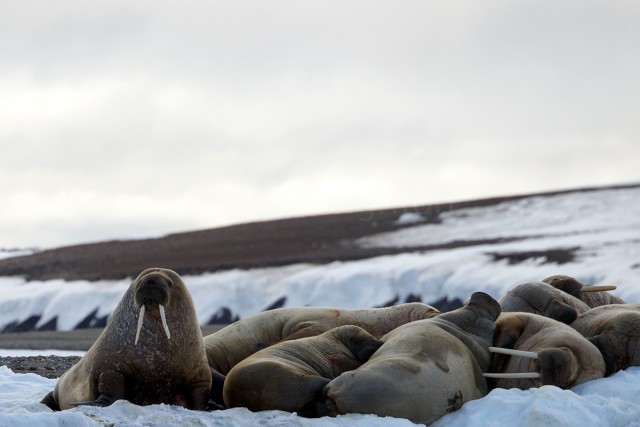
Atlantic Walruses are fascinating. Research them! This is not WalrusReporter! – Photo: Bernie Leighton | WalrusReporter
Two things about zodiac photography. It’s not comfortable. Also, you are always moving, so shoot at high ISO. Imagine lying on a plank of wood, bags, and hard rubber in nearly freezing temperatures. Yeah. Oh well, walruses make you forget how sore you are! Sometimes, you can also see the endemic subspecies of Caribou, known as the Spitsbergen Reindeer.
Honestly, this trip made me tolerate boats. At least if there are critters. I would definitely return to Svalbard or other bear capitals. If you are thinking of doing one, go for it; you won’t regret it!
Comments are closed here.
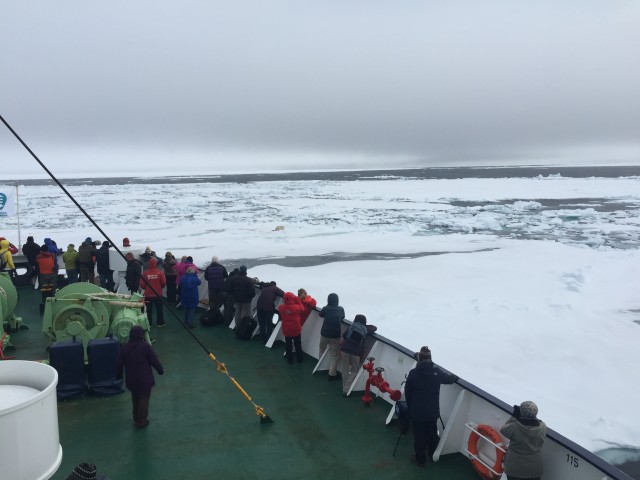
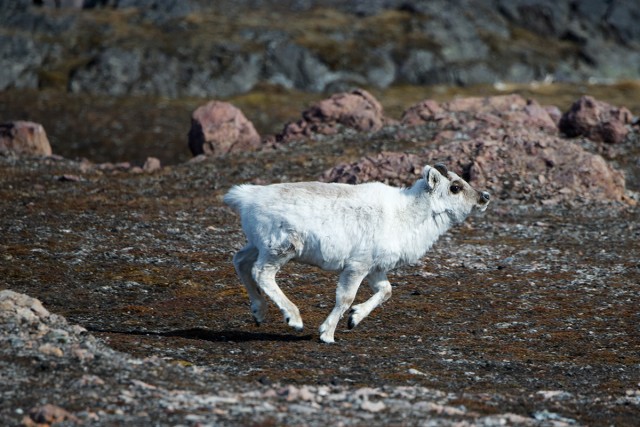
I would like to see some posts on your coming up here to Bush Alaska. I guarantee you, its a whole different world here than anywhere you have ever flown, and flying in Cessna 207 (probably the world’s smallest airliner) is an experience like no other. Thank you for your informative website.
Working on it 🙂
David | AirlineReporter
I wrote one on flying an otter in Alaska a few years back: https://www.airlinereporter.com/2014/05/amazing-experience-flying-alaska-bush-plane-glacier-bay-national-park/